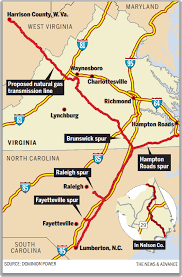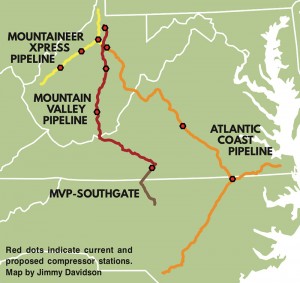From an Article by Maya Weber, S & P Global — Platts, June 1, 2020
Washington — A coalition of environmental groups opened June 1 a new front in their legal war against the 600-mile, 1.5 Bcf/d Atlantic Coast Pipeline project, contending that a supplemental environmental impact statement is needed.
The action comes as lead developer Dominion Energy already is laboring to get the project back into construction after a series of legal setbacks. For instance, it is hoping for a positive US Supreme Court decision soon to help reinstate permission vacated by a federal circuit court for the pipeline to cross the Appalachian Trail.
The project is intended to move Appalachian natural gas to mid-Atlantic markets.
Should the developer prevail in the Supreme Court, it faces a possible new avenue of litigation in the form of a roughly 4,000-page filing posted on the Federal Energy Regulatory Commission’s website June 1 by Southern Environmental Law Center, Appalachian Mountain Advocates and Chesapeake Bay Foundation on behalf of a coalition of conservation groups.
The groups argued in the filing that a supplemental EIS is needed in light of new information that has come to light since FERC issued an EIS for the pipeline project in 2017, and given upcoming FERC decisions on key matters such as whether to extend certificate authorization for the project beyond the October expiration date and whether to lift FERC’s existing stop-work order on construction.
Part of the groups’ rationale for a new review is that the region’s energy infrastructure has undergone a dramatic shift away from gas-fired power, while the cost of the pipeline has ballooned.
“In January 2020, Virginia — the site of over half of the ACP’s proposed route — told the Supreme Court that in light of the mounting evidence that the pipeline is not needed, the ACP threatens Virginia’s natural resources without clear corresponding benefits,” they wrote.
New data for the Federal Energy Regulatory Commission Commission (FERC)
And they said new information has come to light that they contended must be considered under the National Environmental Policy Act, involving endangered species along the pipeline route, expanded scientific information about climate change, and changing circumstances related to cumulative impacts from projects in the area.
In addition, they argued there have been substantial erosion, sedimentation and slope failures since 2017 along the ACP route and other pipelines in mountainous terrain, undermining FERC’s conclusions about effectiveness of mitigation in its documents. In light of the recently narrowed definition of waters of the US, some water bodies crossed by the project, including wetlands, may be at greater risk if permitting authorities no longer consider them within the purview of the Clean Water Act, they said.
“A substantial regulatory change that calls into question key assumptions about water quality protections compels supplementation of the EIS,” they wrote.Dominion Energy response to filings
In response to the filing, Dominion spokeswoman Ann Nallo said many of the concerns raised by the environmental groups already have been addressed publicly and others are being addressed through ongoing permitting processes with the agencies.
For example, ACP is working with the US Fish and Wildlife Service on a new biological opinion that will include the most up-to-date information on the impacted species.
The project is needed more than ever for the region’s economy and path to clean energy, she argued.
“The ACP will also support our region’s transition from coal and the rapid expansion of renewables, both of which are essential to Dominion Energy’s and Duke Energy’s plans to achieve net zero emissions by 2050,” she said.
ClearView Energy Partners, in a research note, said it expects the Supreme Court to remove one obstacle to the Appalachian Trail crossing but emphasized that others remained for the project. ClearView suggested the environmental groups may be preparing to ask the DC Circuit Court of Appeals to stay FERC’s certificate authorization when the court brings a legal challenge related to the FERC authorization out of abeyance.
“Given the strong consensus that the Supreme Court may reverse the 4th Circuit, we see this call to issue a supplemental EIS as another avenue through which the project’s opponents intend to delay, if not try to halt, the project altogether.”



{ 1 comment… read it below or add one }
Friends of Nelson, Nelson County, Blue Ridge Mountains, VA, June 8, 2020
SELC Files Request with FERC for Supplemental EIS for ACP
On June 1, 2020, the Southern Environmental Law Center (SELC) filed a request with the Federal Energy Regulatory Commission (FERC) for a supplemental Environmental Impact Statement for the Atlantic Coast Pipeline “to address significant new information bearing on the ACP’s environmental impacts.” SELC filed the motion asking for the EIS supplement on behalf of 16 organizations, including Friends of Nelson.
The motion lists areas in which new information has arisen since FERC issued the EIS for the ACP in July 2017, and says that new information “presents a seriously different picture of the project’s available alternatives and environmental impacts than the one considered by the Commission.”
Issues considered in the motion include:
Alternatives. The region’s energy future has undergone a dramatic shift away from gas-fired power generation while the ACP’s projected cost has ballooned and its timeline has been pushed back, compelling the Commission to revisit its consideration of alternatives.
Read more here:
http://friendsofnelson.com/selc-files-request-with-ferc-for-supplemental-eis-for-acp/